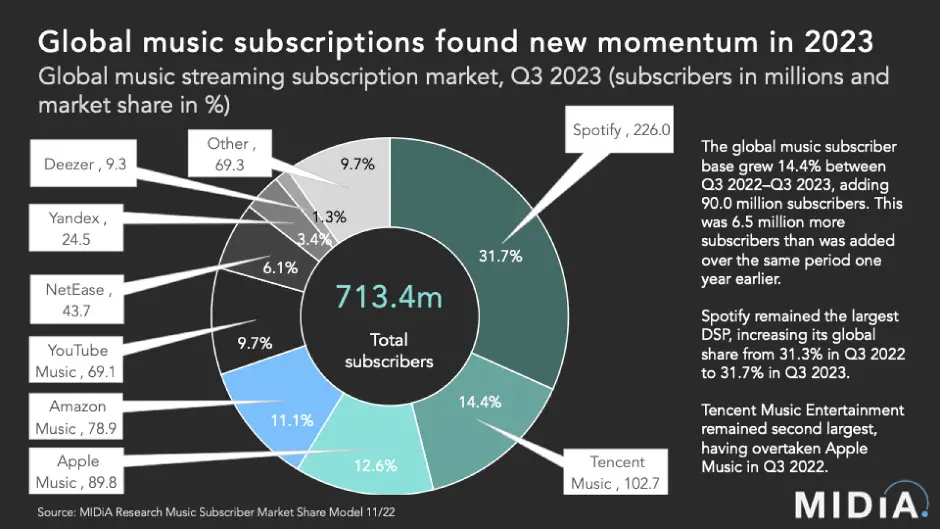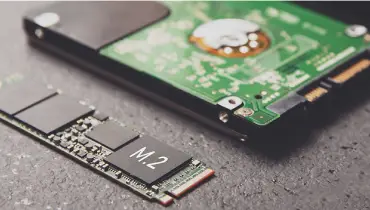How Spotify Pays Ads & Subscription Money to Artists
![How Spotify Pays Ads & Subscription Money to Artists [node:title]](/sites/default/files/styles/wide/public/Spotify%20music%20and%20podcasts%20on%20an%20ipad.jpeg?itok=r9Sb7VU-)
When it comes to music-streaming platforms, Spotify is a giant in the industry. It is one of the most preferred platforms by artists to contribute their streaming content.
If you're an artist looking to contribute your content on the streaming platform and wondering how Spotify pays ads and subscription money to artists, this blog post is for you.
How Much Does Spotify Pay Ads and Subscription Money to Artists?
Spotify has changed how we consume streaming content, providing instant access to millions of music tracks at users' fingertips.
Spotify released the second quarter of 2024 earnings report showing that it has gained more subscribers, more profit, and improved monetization. Spotify reported:
- 14% Y/Y Monthly Active Users growth (626 million).
- 12% Y/Y Growth in Subscribers increased (246 million).
- 20% Y/Y Jump in Total Revenue (€3.8 billion).
- 29.2% Gross Margin.
- Improvement in operating Income (€266 million).
CEO Daniel Ek said:
"It's a great time for us. We'll keep innovating and show how great a product we've and have great business. We're doing so on a timeline that has exceeded even our expectations. This all portends well for the future.”
Revenue Stream: Where Does the Money Come From?
The music-streaming giant's revenue mainly comes from:
- Advertisement;
- Subscriptions.
Advertisers promote their products by paying advertisement fees to Spotify, while users pay monthly fees to enjoy ad-free and premium content.
As of the third quarter of 2023, more than 31% of music streaming subscribers have a Spotify subscription. It's double that of second-ranked Tencent Music. Other services included in this list are Amazon, YouTube, and Apple Music.

Source: (Midia Research)
One of the largest music streaming services, Spotify has an immense number of subscribers and popularity. But Deezer has more subscribers, which shows that the music streaming giant hasn't succeeded in winning the hearts of every streaming fan out there.
Another competitor of Spotify is Apple Music, the service has overtaken Spotify in the United States in terms of paid subscribers. That still does not take away from the value Spotify delivers to content creators and artists.
The process of how money from Spotify ads and subscriptions ends up in the artists' wallets is complex and often misunderstood.
In this post, we’ll explore the mechanisms behind Spotify payments to artists and songwriters, shedding light on the journey from stream to paycheck.
Who Gets Paid?
Spotify pays rights holders through royalties. It's paid to:
- Record Labels;
- Distributors.
Whereas the publishing royalties are paid to:
- Songwriter;
- Owners of a composition.
Spotify pays between $0.003 and $0.005 per stream to the artist on average. This payment depends on where the songs are being played, how often their songs are streamed, and listeners' subscription type. Cut of profit is also provided to the record label and distributors.
In short, the streaming platform does not pay directly. Instead, Spotify pays music rights holders, which mainly includes aggregators, record labels, collecting societies, and distributors. These entities are later distributed to the artists based on contract terms.
For self-distributed or independent artists, the money is often funneled through aggregators including TuneCore or DistroKid, which charges negligible fees for passing on the majority of the royalties.
Streamshare Model: How Payments Are Calculated
Wondering how Spotify calculates advertisement and subscription payments before paying to an artist? Spotify works on a 70/30 revenue split. It's distributed as below:
- 70% of revenue goes to artists/rights holders;
- 30% of revenue goes to Spotify.
The song rights holders include master record owners, publishers, and songwriters. Unlike album buying where a percentage goes to the artist, stream share is divided among rights holders based on the music stream number received in a given market.
For example, if a rights holder’s music accounts for 25% of all streams in the U.S. during a particular month, they receive 25% of the total revenue generated from subscriptions and ads in that market. This method is standard across major streaming platforms like Amazon Music and Apple Music.
Per-Stream Payouts Myth: What Not to Believe?
There is a misconception that one is paid a set amount per stream, mainly around $0.003 to $0.005 per play. This however doesn't show how royalties are distributed. Every artist doesn't receive the same payout. Payments are not calculated on a per-stream basis but are instead derived from the overall revenue generated and the artist’s share of total streams.
For example, if any users spend around $20 on a subscription and listen to one song that month, the rights holder theoretically earns $17 from that stream. However, if that user continues to listen to more than one song, the payout per stream drops significantly.
Challenges for Artists
The streamshare model disproportionately benefits artists with massive streaming numbers, often leaving independent and niche artists with minimal payouts. Additionally, Spotify’s decision to withhold payments for songs with fewer than 1,000 annual streams has further concentrated revenue among top-streaming artists.
Moreover, the system favors music that fits the streaming platform’s algorithms. These include:
- Short tracks,
- Catchy tracks,
- Most loved tracks that are likely to be replayed.
Artists who create long-form compositions or experimental tracks find it challenging to get the pay they aim for. However, these types of works may not generate the same volume of streams.
Streaming Royalties Future: Explore Everything Here!
With the music industry increasing streaming dominance, there is growing pressure to reform how royalties are paid. This is a user-centric payment model, where royalties are divided based on individual users' listening habits. It's more effective than distributing royalties based on the total number of streams. This system mainly helps a music streaming giant to offer fairer compensation to independent and niche artists.
In the U.S., legislation like the Living Wage for Musicians Act proposes a new streaming royalty to ensure artists receive at least one cent per stream, funded by a levy on streaming platforms’ non-subscription revenues.
Conclusion
While Spotify has made it easier than ever for artists to reach a global audience, the current payment model presents significant challenges for many musicians, particularly those who don’t generate massive streaming numbers.
As the industry evolves, it’s crucial to explore alternative models that offer fairer compensation to all artists, not just those at the top of the charts.


















![Key Ways Outdoor Social Activities Make You Healthier & Happier [node:title]](/sites/default/files/styles/video_thumbnail_bottom/public/why-outdoor-social-activities-make-you-healthier.jpg?itok=axCzjZVj)

